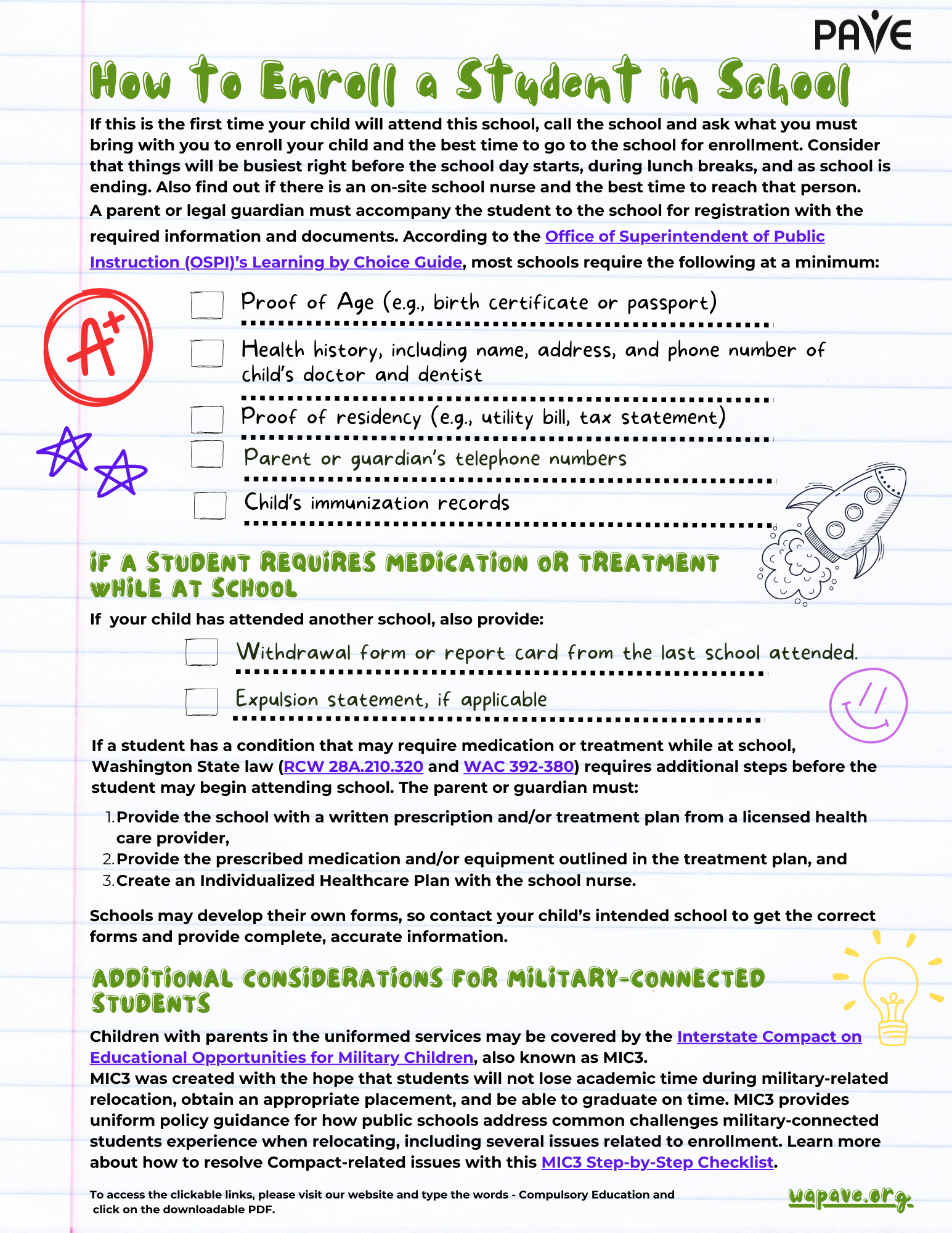A Brief Overview
- Compulsory attendance begins at 8 years of age and continues until the age of 18 unless the student qualifies for certain exceptions.
- Infants and toddlers receiving early intervention services may be eligible to start preschool as early as 3 years old to continue receiving specialized instruction and related services.
- A student aged 4 years old by August 31 may be screened for Transition to Kindergarten (TK), a state program designed for students who need additional support to be successful in kindergarten the following year.
- A child must have turned 5 years old by August 31 to enroll in kindergarten, and 6 years old to enroll in first grade.
- When registering your student for school, contact the school to find out what documents are required in addition to those listed in this article.
- Students with a condition that may require medication or treatment
Full Article
If your child has never enrolled in school, back to school season can be a confusing time. This article answers frequently asked questions about school entrance age, compulsory education, and the enrollment process. Note that “enrollment” and “registration” are used interchangeably regarding the steps leading up to a student starting school and within the OSPI (Office of Superintendent of Public Instruction) website.
At what age are children required to attend school?
Federal law protects the rights of children and youth to receive a publicly funded education. This is called compulsory education, or compulsory attendance. The age at which a child must begin school varies by state. In Washington state, children must begin attending school full-time at the age of 8 and continue attending regularly until the age of 18 (RCW 28A.225.010).
There are some exceptions to compulsory attendance, including if a child is –
- enrolled in a private school, extension program, or residential school operated by the Department of Social and Health Services (DSHS) or the Department of Children, Youth, and Families (DCYF).
- enrolled in home-based instruction that meets State supervision requirements.
- excused by the school district superintendent for physical or mental incapacity.
- incarcerated in an adult correctional facility.
- temporarily excused upon the request of the parents when the excused absences meet additional requirements under Washington state law (RCW 28A.225.010).
Compulsory attendance is required in Washington until the age of 18, unless the student is 16 years or older and meets additional criteria for emancipation, graduation, or certification (RCW 28A.225.010).
At what age can a student begin attending school?
Students with special needs or disabilities may qualify for early education programs. An infant or toddler with a disability or developmental delay receiving early intervention services may be eligible to start preschool between the ages of 3-5 to continue receiving specialized instruction and related services through the public school district until they reach the minimum enrollment age for kindergarten. Washington’s Transition to Kindergarten (TK) program screens 4-year-olds with a birthday by August 31st to identify those in need of additional preparation to be successful in kindergarten.
Parents may choose to enroll a child in kindergarten at 5 years old, if the birthday occurred before August 31st of the same year, but kindergarten is not required under compulsory education. Similarly, a child must be 6 years of age to enroll in first grade.
Families have the right to choose whether to enroll their students in school until the child turns 8 years old and compulsory attendance applies.
How do I enroll my student in school?
If this is the first time your child will attend this school, call the school and ask what you must bring with you to enroll your child and the best time to go to the school for enrollment. Consider that things will be busiest right before the school day starts, during lunch breaks, and as school is ending. Also find out if there is an on-site school nurse and the best time to reach that person.
A parent or legal guardian must go with the student to the school for registration with the required information and documents. According to the Office of Superintendent of Public Instruction (OSPI)’s Learning by Choice Guide, most schools require the following at a minimum:
- Proof of age (e.g., birth certificate or passport).
- Health history, including name, address, and phone number of child’s doctor and dentist.
- Proof of residency (e.g., utility bill, tax statement).
- Parent or guardian’s telephone numbers.
- Child’s immunization records.
If your child has attended another school, also provide:
- Withdrawal form or report card from the last school attended.
- Expulsion statement.
Enrollment for Military-Connected Students
A Washington law passed in 2019 (HB 1210-S.SL, School Enrollment-Nonresident Children from Military Families) allows advance enrollment of children of active-duty service members with official military orders transferring or pending transfer into the state. This means that qualifying children must be conditionally enrolled in a specific school and program and registered for courses. The parent must provide proof of residence within fourteen days of the arrival date listed in the military orders before the school will finalize the enrollment. The address on the proof of residency may be a temporary on-base detailing facility; a purchased or leased residence, or a signed purchase and sale or lease agreement; or military housing, including privatized and off-base housing. The child will be conditionally enrolled and registered for courses.
Schools are responsible for the health and safety of students during all school-related activities. If a student has a condition that may require medication or treatment while at school, Washington state law (RCW 28A.210.320 and WAC 392-380) requires additional steps before the student may begin attending school. The parent or guardian must:
- Provide the school with a written prescription and/or treatment plan from a licensed health care provider,
- Provide the prescribed medication and/or equipment outlined in the treatment plan, and
- Create an Individualized Healthcare Plan with the school nurse.
Schools may develop their own forms, so contact your child’s intended school to get the correct forms and provide complete, accurate information.
Download How to Enroll a Student in School Handout

Additional Considerations for Military-Connected Students
Children with parents in the uniformed services may be covered by the Interstate Compact on Educational Opportunities for Military Children, also known as MIC3, was created with the hope that students will not lose academic time during military-related relocation, obtain an appropriate placement, and be able to graduate on time. MIC3 provides uniform policy guidance for how public schools address common challenges military-connected students experience when relocating, including several issues related to enrollment. Learn more about how to resolve Compact-related issues with this MIC3 Step-by-Step Checklist.
Families who are new to Washington can learn more about navigating special education and related services in this article, Help for Military Families: Tips to Navigate Special Education Process in Washington State.
Additional Information
- Back To School Checklist!
- Early Intervention: How to Access Services for Children Birth to 3 in Washington
- Help for Military Families: Tips to Navigate Special Education Process in Washington State
- Navigating Life After Early Intervention Services
- OSPI’s Learning by Choice (2014): A downloadable PDF guide available in English and Spanish.
- Toolkit Basics: Where to Begin When a Student Needs More Help

